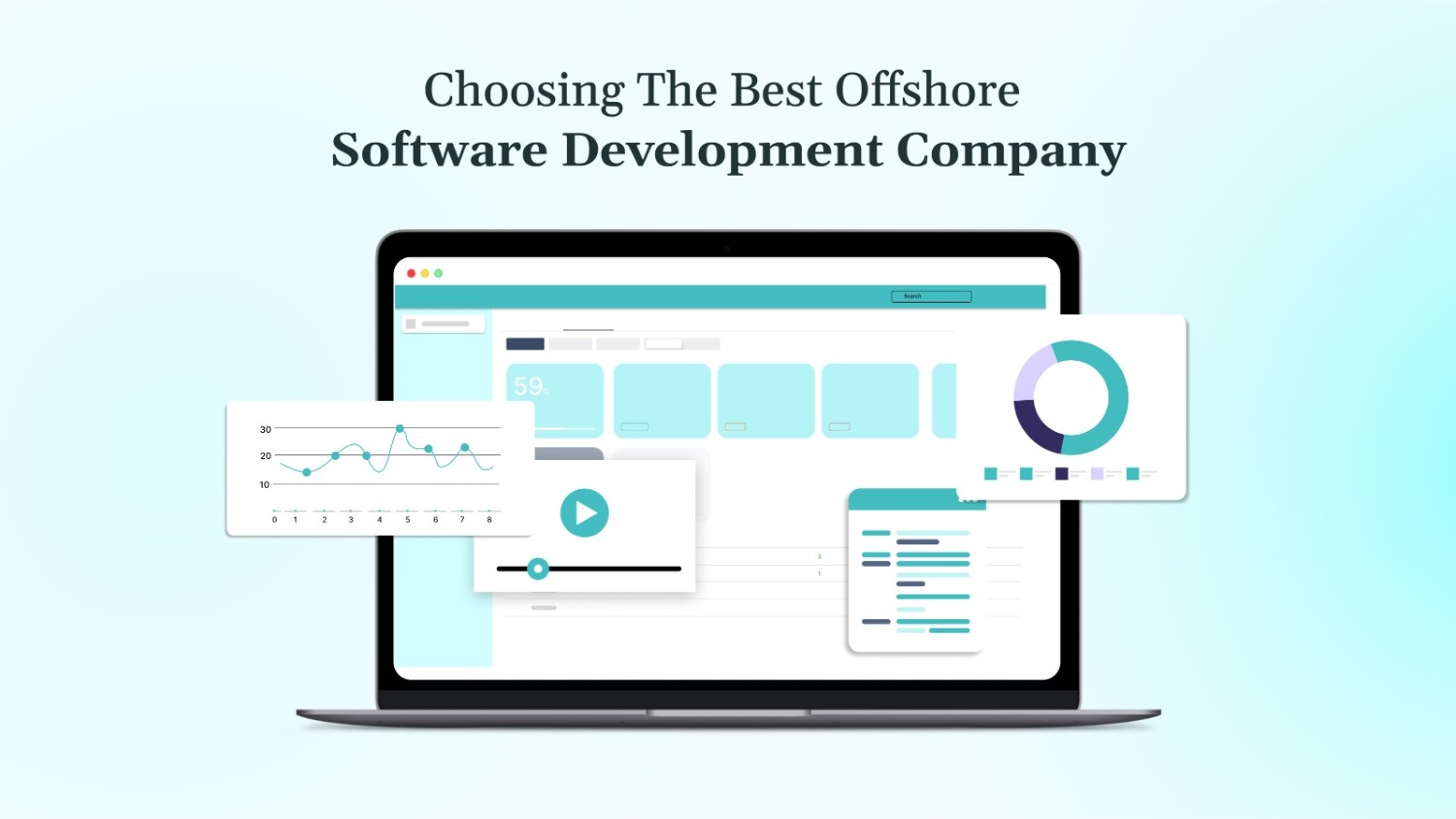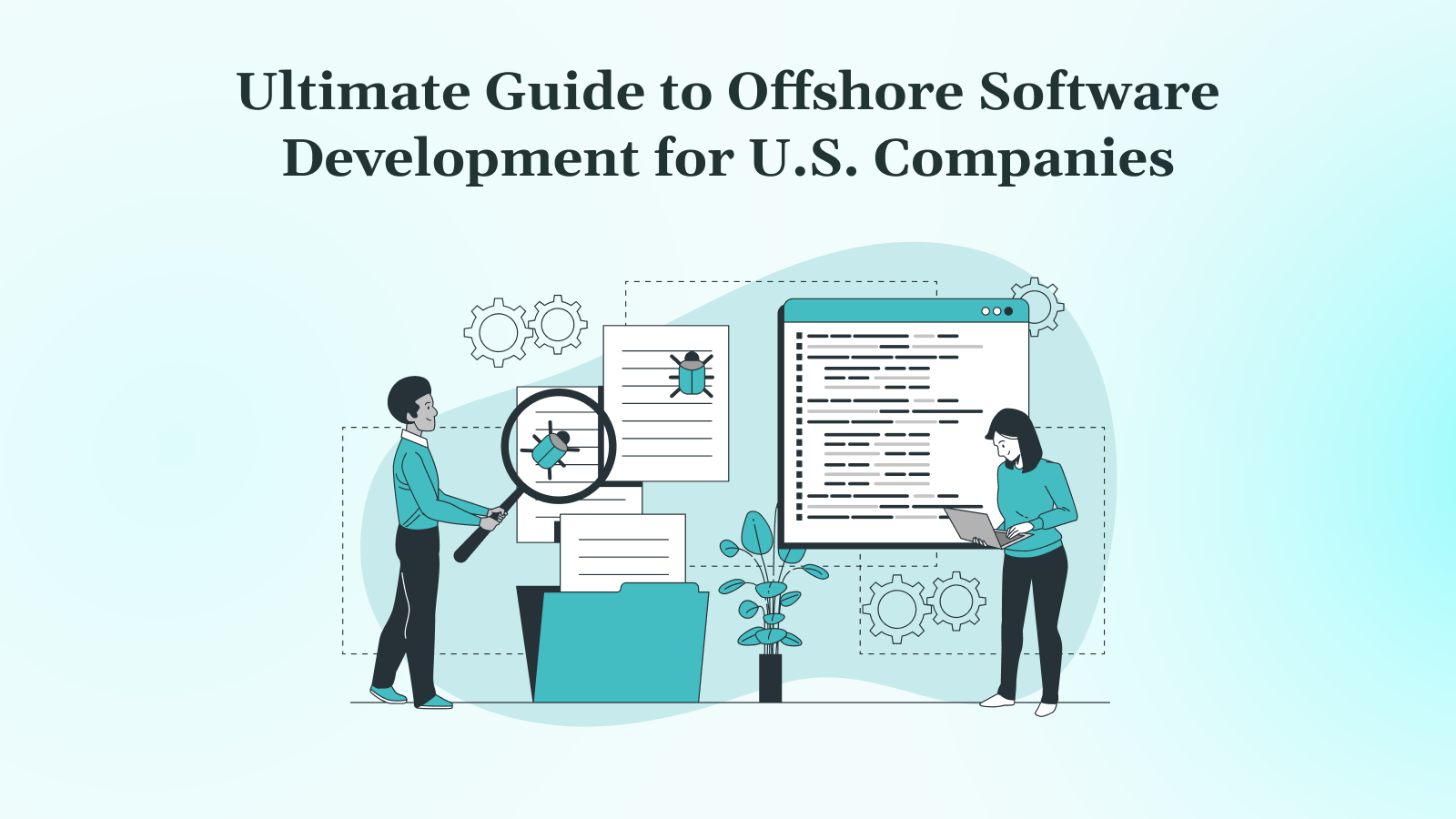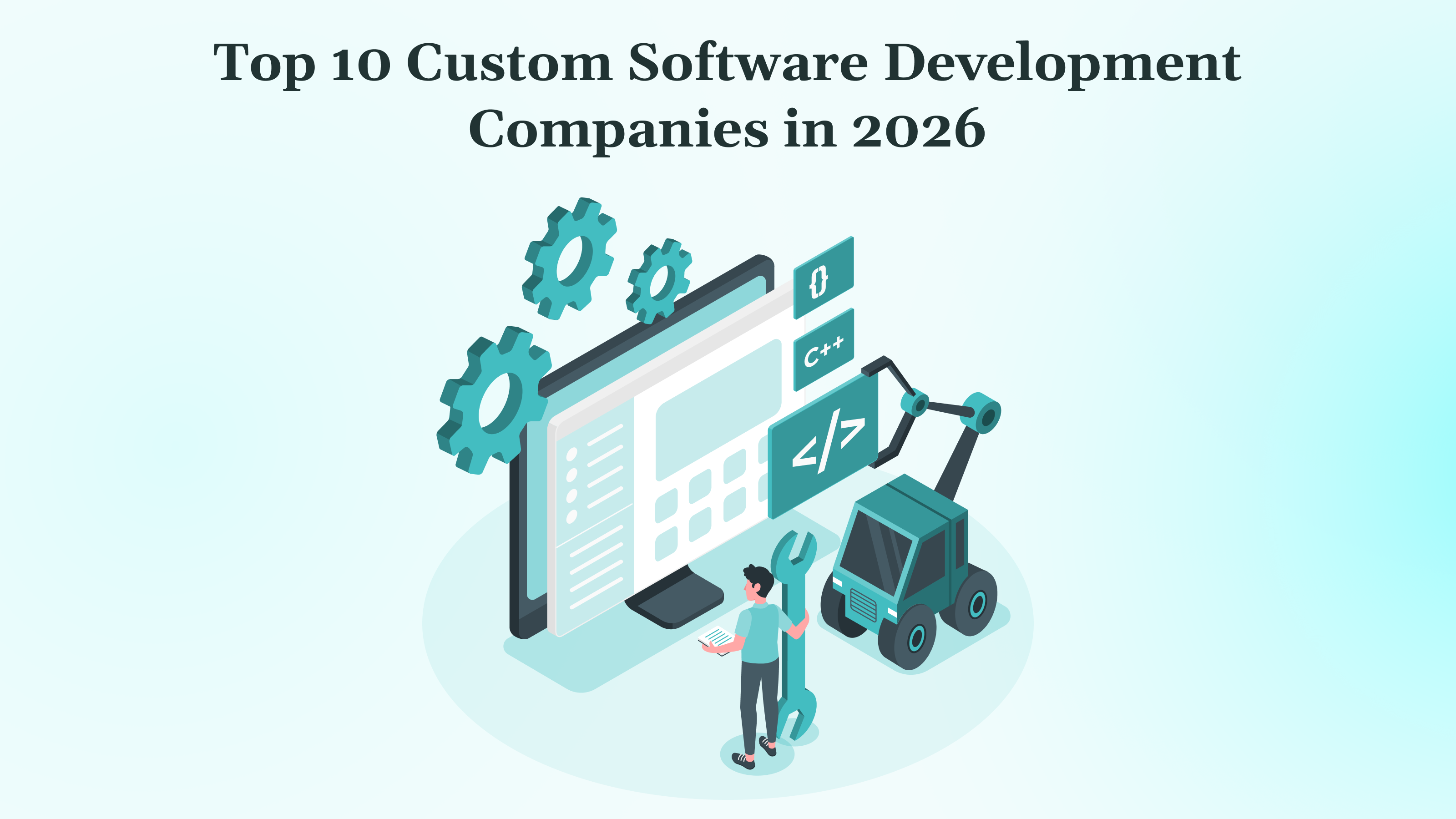In an increasingly competitive tech landscape, offshore software development remains a strategic lever for companies aiming to cut costs, access specialized talent, and accelerate delivery. In 2025, offshore teams will provide global expertise, round-the-clock development capacity, and comprehensive compliance practices.
Successful offshoring requires thoughtful governance to mitigate communication gaps, time‑zone challenges, and security concerns. This guide breaks down everything you need, from core benefits and common pitfalls to top providers and best practices. All of this so you can confidently select and manage an offshore partner.
Key Takeaways
- Definition & overview: Understand what offshore software development entails and why it is relevant in 2025.
- Significant benefits: Learn about cost savings, global talent access, 24/7 cycles, hybrid models, and security frameworks.
- Common challenges: Explore barriers like culture, time zones, oversight, and legal issues, along with how to overcome them.
- Top offshore firms: Get profiles of leading providers, including DEVtrust, SumatoSoft, BairesDev, and more.
- Actionable guidance: Discover evaluation criteria and best practices for managing offshore collaborations successfully.
What Is Offshore Software Development?
Offshore software development is the practice of delegating software work, such as coding, testing, maintenance, or DevOps, to teams located in a different country, typically one with lower labor costs. These teams operate remotely and function much like an extension of your in‑house team, but deliver solutions from abroad.
The model has deep roots: since the 1960s, global companies have set up software hubs in countries like India, Ukraine, and China to tap into skilled yet more affordable talent pools.
Businesses choose offshore development to bridge local talent shortages, reduce expenses, and speed up delivery. By leveraging modern communication tools, these teams operate across borders seamlessly, even across multiple services
These include SaaS, mobile apps, cybersecurity, and AI/ML development. Global offshore software spending is booming, the market is valued at around $162 billion in 2024 and is projected to hit ~$180 billion in 2025, with steady growth expected through 2033 at annual rates of 10‑11%.
Offshore outsourcing contrasts with nearshore (within nearby countries) and onshore (within the same country). Offshore typically offers the most significant cost advantage but introduces challenges like time‑zone gaps and cultural distance, making strong process control and communication protocols critical. Let us explore the key benefits of offshore software development companies.
Key Benefits Of Offshore Software Development Companies
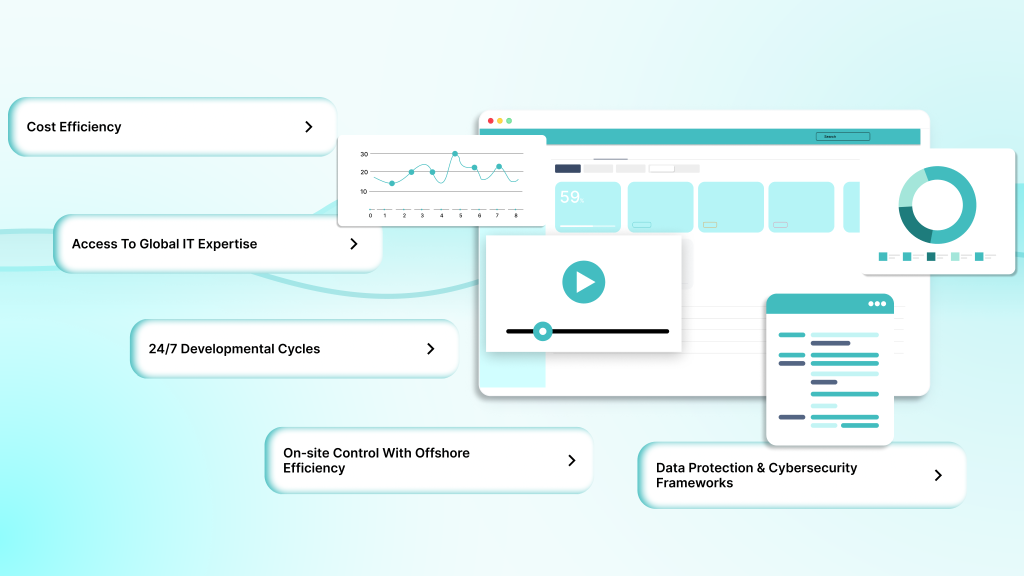
Offshore software development offers strategic value beyond just lower costs. It provides enterprise-grade advantages, from global skills access to continuous delivery workflows. Below, we explore the core benefits in depth.
Cost Efficiency
Offshore development delivers substantial financial advantages. You pay lower labor rates compared to domestic markets. This includes not only salaries but also reduced overhead; they manage office spaces, hardware, and utilities. Development budgets stretch further. That means you can invest saved resources into innovation or marketing. It also enables faster scaling without the burden of hiring or infrastructure.
Access To Global IT Expertise
When you work offshore, you tap into a vast pool of talent. Many regions cultivate deep skills in emerging technologies such as cloud, AI/ML, blockchain, or mobile architecture. These specialists fuel innovation and quality.
Cultural diversity brings fresh perspectives. The team’s previous experience across industries sharpens problem‑solving. You get diverse insights that often lead to more innovative, more scalable solutions.
24/7 Developmental Cycles
Global teams offer continuous delivery thanks to time-zone differences. While your core team sleeps, offshore developers build, test, and iterate. Work passes across borders, achieving near round‑the‑clock progress.
This accelerates project timelines and shortens release cycles. The model is sometimes called “follow‑the‑sun” development, where teams hand off tasks daily to maintain momentum. When managed well, this setup can cut delivery time dramatically and drive faster innovation.
On‑site Control With Offshore Efficiency
You can combine local oversight with offshore execution. Key project activities like sprint planning, architecture decisions, and feature demos can stay in‑house or nearshore. Meanwhile, offshore teams handle the coding, QA, and integration. This hybrid setup retains control and visibility. At the same time, it maximizes cost advantage and flexibility. You get tight governance without the high fixed costs of a whole in‑house team.
Data Protection & Cybersecurity Frameworks
Security and regulatory compliance are non‑negotiable in offshore partnerships. Leading offshore providers adopt frameworks like ISO/IEC 27001 or NIST standards to protect data transit and storage.
They use layered security like secure coding, encryption, SIEM tools, and incident response planning. Contracts include strong NDAs and IP clauses. This approach helps ensure confidential information stays protected. You get offshore scale without compromising security or compliance.
This explains why offshore development matters in 2025. You can now understand its operating model, how it boosts value, and how strategic security and governance make it enterprise-ready. Note that there may be some challenges in offshore software development as well.
Challenges In Offshore Software Development And How To Overcome Them
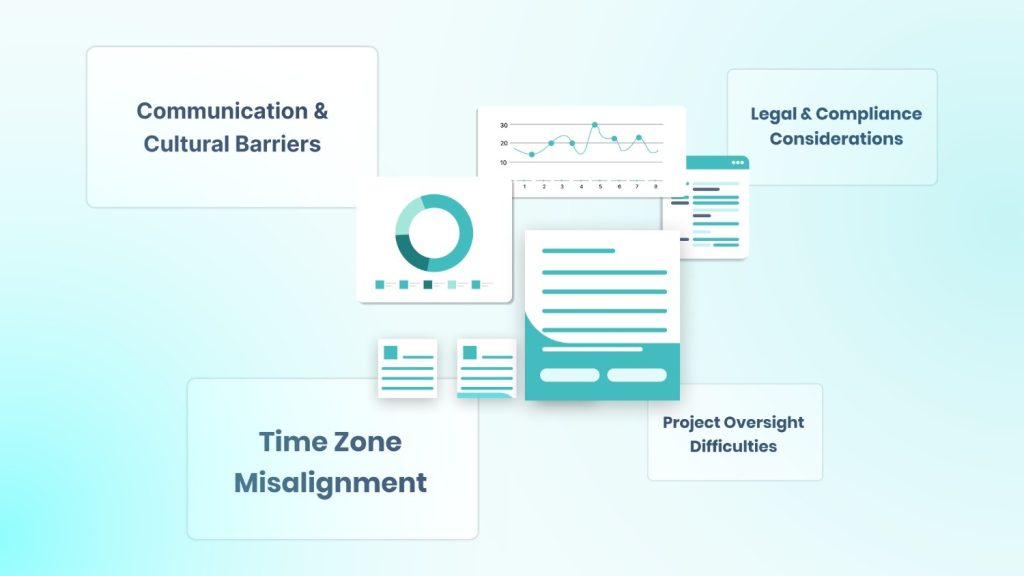
Offshoring brings substantial advantages, but also real hurdles. Without careful planning, these challenges can slow delivery or reduce quality. In the following text, each set of challenges is paired with practical approaches that restore control and keep projects on track.
Communication And Cultural Barriers
Effective collaboration demands cultural clarity and communication discipline. Teams may speak the same language but interpret tone, formality, and intent differently. For example, developers from some regions may avoid saying “no” directly.
Other teams expect frequent informal updates rather than formal documentation. These mismatches can cause confusion and friction.
To bridge these gaps, it helps to set clear protocols. Define channels for routine updates, urgent questions, or formal handoffs. Encourage writing in simple language and supplement verbal exchanges with diagrams or flowcharts to reduce ambiguity .
Provide cultural guidance or joint workshops that explain decision styles, response norms, and feedback expectations . Over time, these practices become part of the shared operating culture and reduce misunderstandings.
Time Zone Misalignment
When teams are separated by many hours, delays become built in. A request may wait an entire day before being seen. A blocker in one region can stall others. This slows momentum and can frustrate both sides.
To manage this, identify overlapping hours where both teams can collaborate live. Even two to four shared hours each day helps with sprint planning, issue resolution, and stand‑ups. Outside these hours, rely on structured asynchronous methods.
Each day, the outgoing team shares progress, blockers, and next steps in task tools like Jira or Slack . This “handoff” ensures work continues without gaps. Tools like shared calendars and rotating meeting schedules also spread the meeting burden fairly.
Project Oversight Difficulties
Distributed teams can drift without precise alignment. Delayed feedback and limited visibility may lead to stale work. Fatigue sets in if people stretch to join meetings at odd hours.
One strong solution is to embed transparent reporting and local accountability. Have a local or onshore project manager act as liaison. This person monitors KPIs, clarifies priorities, and ensures feedback reaches the offshore team promptly.
Schedule regular status checkpoints via recorded updates if live participation is impossible. Keep work handoffs structured, with expectations clear at each step . Encourage team-wide retrospectives or feedback sessions to identify friction early and adjust workflows.
Legal And Compliance Considerations
Offshoring often involves sensitive data, intellectual property, and regulatory oversight. Different jurisdictions have distinct laws like GDPR, HIPAA, or local data privacy acts. Missteps can expose your organization to risk .
To protect your interests, start with solid contracts. Define working hours, holidays, response expectations, and escalation rules; all in writing . Include strong confidentiality clauses, IP ownership terms, and compliance requirements.
Confirm the vendor follows recognized security frameworks and standards such as ISO 27001 or PCI protocols to protect sensitive data. Require periodic audits or breach reporting. This governance ensures that scaling offshore doesn’t sacrifice legal clarity or security.
By addressing cultural differences, structuring time‑zone workflows, reinforcing oversight, and formalizing legal safeguards, engineering leaders can transform offshore challenges into manageable elements. Some offshore software companies in 2025 are raising the standards.
Top Offshore Software Development Companies In 2025

This section profiles leading offshore software development providers for 2025. Each firm is described in four to five expert‑tone lines, followed by four top features, and a two‑line summary of its ideal use case.
DEVtrust
DEVtrust is headquartered in Lucknow, India, with a client‑facing presence in the U.S. It specializes in API integration, cloud architecture, and full‑stack product delivery. Their approach blends local strategic oversight with offshore execution.
The team is experienced across industries like HealthTech, FinTech, EduTech, logistics, and AI/ML deployments. Read our HealthTech case study with Must Motivate, where we helped with a unified data interface and a mental health assessment tool.

Why Choose DEVtrust?
- Located in India with U.S. operations for client coordination.
- Focus on Node.js, React, Django, Python, AWS, Firebase, and Stripe.
- Combines staff augmentation with full outsourcing and hybrid models.
- Emphasizes transparent communication and governance.
Best for businesses seeking flexible offshore execution while maintaining strong control and industry‑specific expertise.
SumatoSoft
SumatoSoft has served its clients since around 2012 and delivers custom software primarily in React.js, Node.js, and Ruby on Rails. Their teams operate in a transparent workflow model and emphasize frequent demos and direct communication. They have built solutions in IoT, fintech, healthcare, and SaaS across many countries.
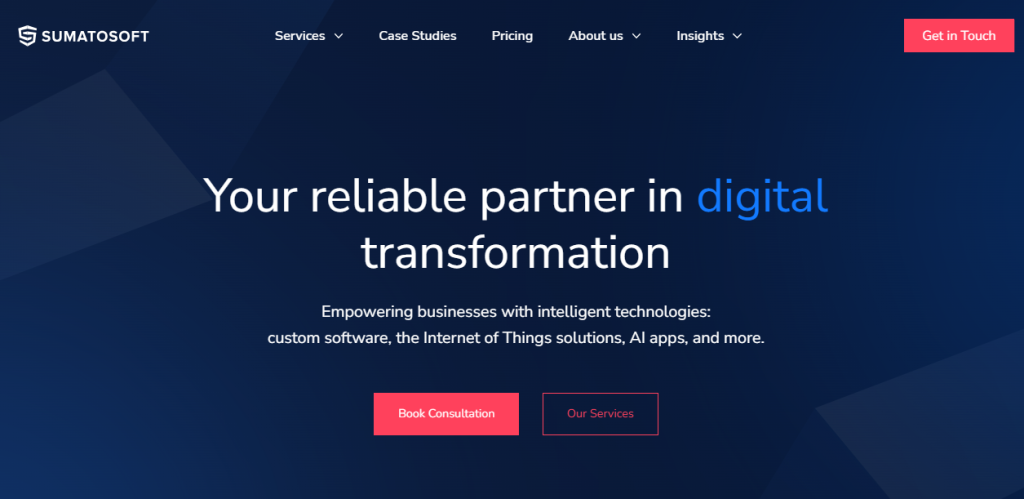
Why Choose SumatoSoft?
- Strong focus on RoR, React, Node stacks.
- Transparent project process with frequent client touchpoints.
- Broad industry coverage, including IoT and Healthcare.
- Experience with mid-market and enterprise clients globally.
Ideal for organizations requiring clear communication and modern tech stacks in domains such as fintech and IoT.
Sigma Software
Sigma Software is part of the Sigma group, with development centers in Ukraine and India, and offices across Europe and the U.S. They offer full lifecycle product development, embedded and IoT systems, AI/ML, and digital transformation consulting. Sigma is ISO 9001 and ISO 27001 certified and a Microsoft Gold Partner.
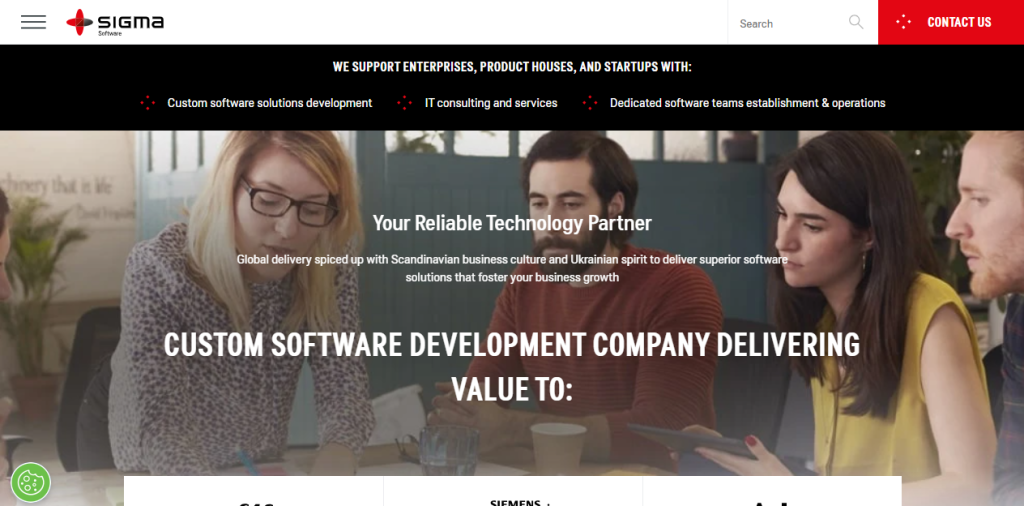
Why Choose Sigma Software?
- Wide global footprint across multiple countries.
- Enterprise-grade process maturity and security certifications.
- Deep expertise in AI, IoT, embedded systems, and compliance.
- Mix of product development, consulting, and dedicated teams.
Ideal for enterprises seeking high-assurance engineering in regulated or complex technical domains.
The Scalers
The Scalers builds and manages dedicated tech teams from India, combining local control with offshore cost efficiency. They focus on retention-oriented hiring, Westernized management standards, and culture alignment. They serve both startups and established companies with scalable, team-centric models.
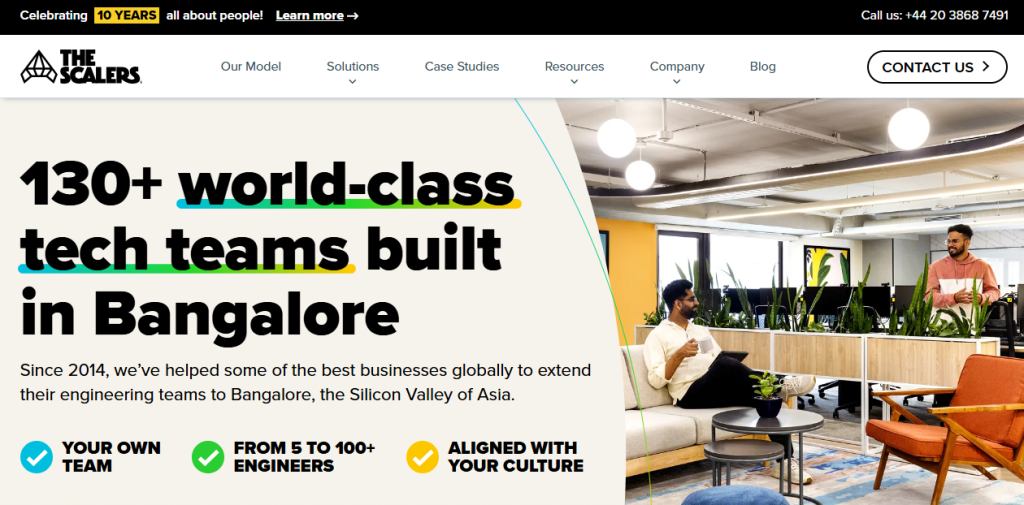
Why Choose The Scalers?
- Custom-built offshore teams aligned with client culture.
- Focus on long-term staff retention and engagement.
- Western-style management, ISO-aligned processes.
- Flexible scaling suited to growth-stage companies.
Best choice for firms needing a dedicated offshore team that feels like an in‑house extension.
Value Coders
Value Coders is a longstanding India-based provider, trusted by startups and Fortune‑level clients. They specialize in AI/ML, RPA, IoT, AR/VR, and web/cloud-based solutions. They support startup MVPs and enterprise-scale transformation projects.
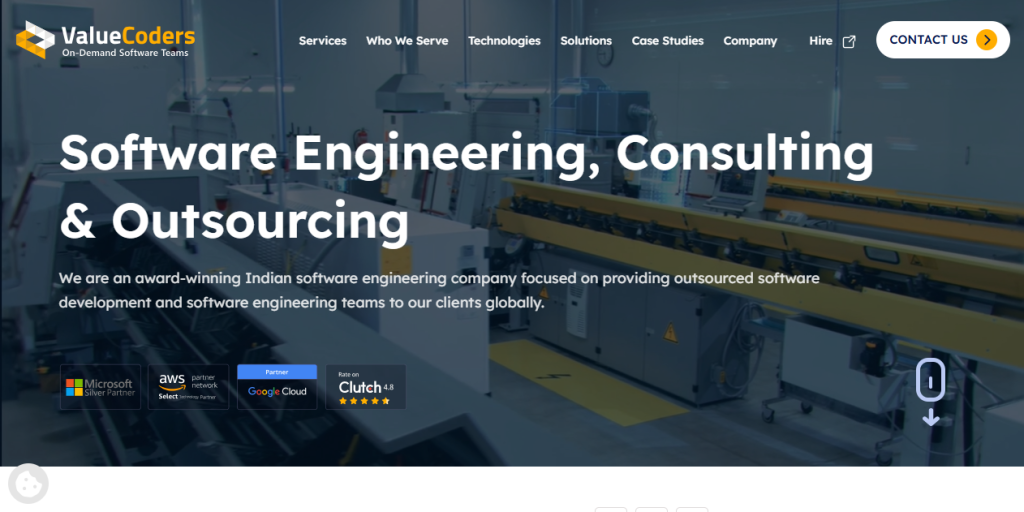
Why Choose Value Coders?
- India’s top 1% developer talent and deep domain expertise.
- Rich experience in AI/ML, RPA, IoT, AR/VR solutions.
- Flexible engagement: dedicated teams, ODCs, staff augmentation.
- Emphasis on data security, NDA adherence, and regulatory compliance.
Most suitable for clients needing cutting-edge tech solutions with flexible collaboration models.
BairesDev
BairesDev operates a modern offshore delivery model focused on Latin America but accessible globally. They offer end-to-end development in web, mobile, AI, and cloud stacks. They highlight high retention rates, rapid scaling, and proximity to North American time zones.

Why Choose BairesDev?
- Full-cycle software engineering across platforms.
- Skilled talent pool in Latin America with U.S. overlap.
- Fast team scaling and high retention.
- Consistent use of Agile and client‑aligned processes.
Ideal for U.S. and Canadian clients needing time-zone alignment and fast scaling while retaining quality.
IntellectSoft
IntellectSoft provides custom software development with a strong focus on enterprise digital transformation. They work across fintech, healthcare, telecom, and travel segments. Their strength lies in secure mobile apps, blockchain, and cloud migration projects.
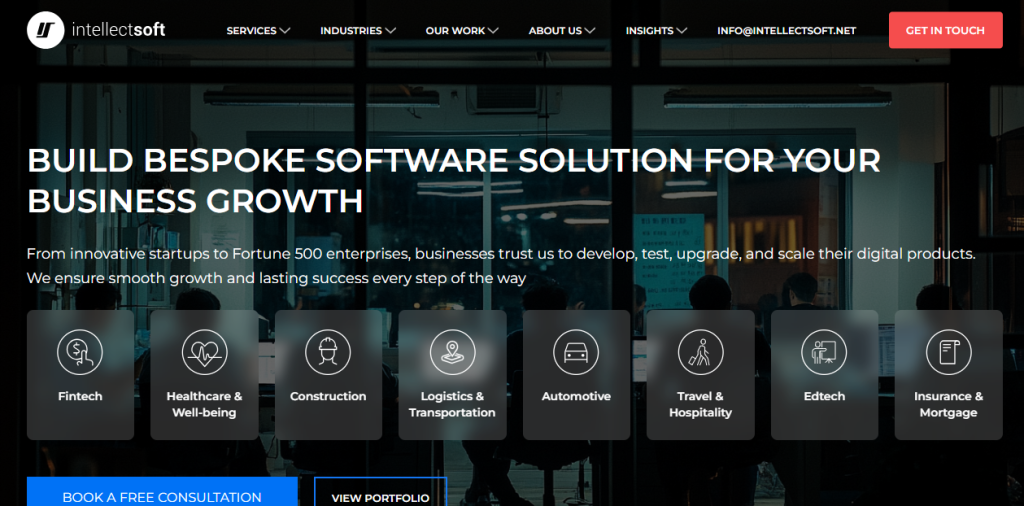
Why Choose IntellectSoft?
- Enterprise solution delivery and digital transformation capabilities.
- Blockchain, fintech, and mobile security expertise.
- Cross-industry experience with a compliance focus.
- Combination of consulting and delivery models.
Best for large organizations seeking secure, regulated enterprise digital systems.
Belitsoft
Belitsoft is a European-Russian development company offering software outsourcing and consulting. They build custom web and mobile apps, e‑learning platforms, and legacy system modernization. They serve clients in e‑commerce, healthcare, and corporate training markets.

Why Choose Belitsoft?
- e‑learning and training platform specialization.
- Legacy modernization and web/mobile development.
- Flexible, small to medium team engagement.
- Consulting support with a focus on usability and design.
Well matched to businesses looking to modernize legacy systems or build e-learning and enterprise applications.
ANGLER
ANGLER is an Eastern European offshore provider focused on scalable team growth for startups and product companies. They work in mobile, SaaS, AI/ML, and custom web platforms. They provide development, QA, and DevOps services with hands-on collaboration.
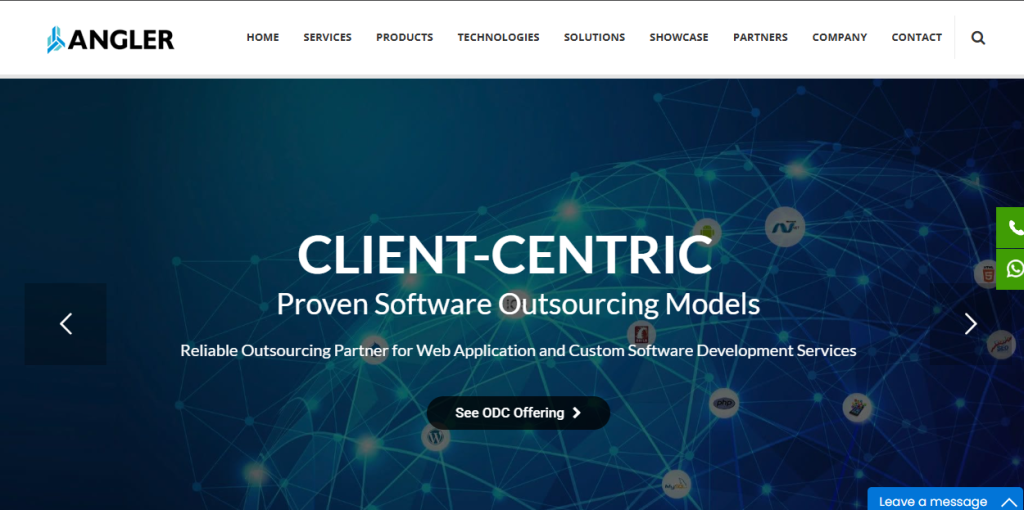
Why Choose ANGLER?
- Startups and product firms as core clientele.
- Broad stack covering mobile, web, AI/ML, QA.
- Agile, collaborative development approach.
- Focus on product-market fit and rapid iteration.
Best for product-oriented startups needing a full suite of scalable engineering support.
Devox Software
Devox Software provides offshore development from Eastern Europe and Latin America. They offer web and mobile development, AI, blockchain, and IoT services. Their model centers on flexible team setups and rapid deployment capability.
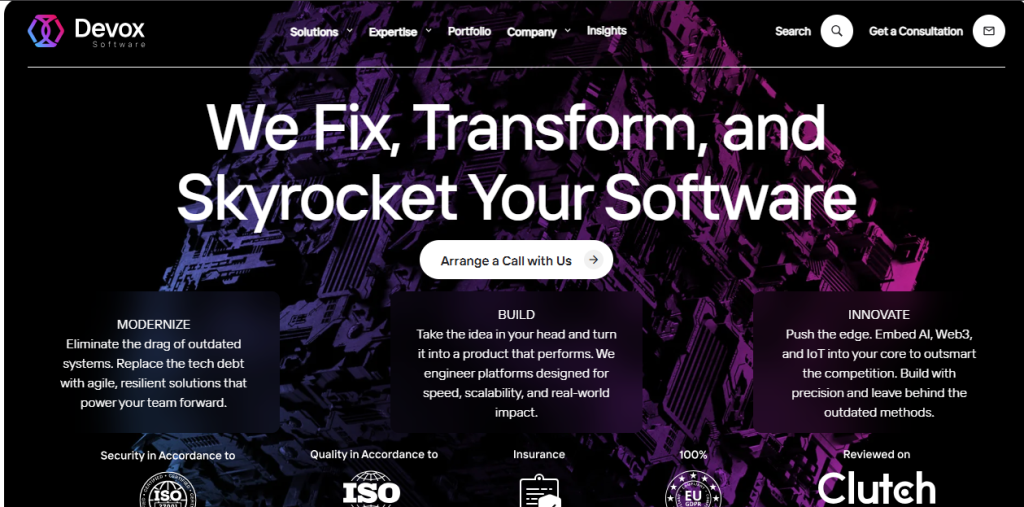
Why Choose Devox Software?
- Multi-region team model for flexibility.
- Services include AI, blockchain, IoT, and mobile app development.
- Fast ramp-up and flexible contracts.
- Emphasis on client responsiveness and partnership.
Ideal for clients needing rapid team scaling in emerging tech stacks across regions.
Here is a tabular comparison of the top offshore software development companies:
| Company | U.S. Presence + India Hub | Modern Tech Stack (React/Node/Python) | Security & Compliance Certifications | Transparent, Frequent Communication | Team Retention & Stability |
| DEVtrust | ✅ | ✅ | ✅ | ✅ | ✅ |
| SumatoSoft | ✅ | ✅ | — | ✅ | ✅ |
| Sigma Software | ✅ | ✅ | ✅ | — | ✅ |
| The Scalers | ✅ | ✅ | ✅ | — | ✅ |
| Value Coders | ✅ | ✅ | — | — | ✅ |
| BairesDev | ✅ | ✅ | — | — | ✅ |
| IntellectSoft | ✅ | ✅ | ✅ | — | ✅ |
| Belitsoft | ✅ | ✅ | — | — | ✅ |
| ANGLER | ✅ | ✅ | — | — | ✅ |
| Devox Software | ✅ | ✅ | — | — | ✅ |
The choices remain diverse. How can one evaluate which company is worth it?
How To Evaluate The Right Offshore Software Development Company
Choosing the best offshore partner requires careful planning and aligned priorities. Start by grounding your decision in clear objectives. Then assess the vendor’s skills, processes, and ethics. Finally, secure legal protections that uphold your interests. Each of these areas deserves in-depth, structured attention to ensure a successful, long-term relationship.
Define Your Needs
Begin by clarifying and communicating your business goals and project scope. Understand whether you need staff augmentation, a full product build, or ongoing support. Be precise about deadlines, deliverables, and critical outcomes.
Share real use cases and desired outcomes with potential partners to ensure alignment. This clarity sets the tone for collaboration and expected accountability. DEVtrust ensures transparent communication and understanding of needs with its clients. Know about how we helped Credenza in security and AI-powered credential management through clear-cut communication.
Assess Individual Features
When evaluating vendor capabilities, examine the quality of their talent and the match with your project’s tech stack. Request detailed resumes or profiles of proposed engineers. Ask about experience with frameworks like Node.js, React, Django, or cloud platforms your team uses.
Review their portfolio and case studies deeply. Ask probing questions: What problem did they solve? How did they approach it? How did they manage complexity without hand-waving?
Interview key team members to see if they understand your needs and communicate clearly. This direct vetting ensures you’re working with capable professionals, not just names on paper.
Review Communication And Reporting Strategy
Communication must be structured, transparent, and responsive. Confirm that the vendor promotes real-time access to developers or engineers, not just filtered updates through managers. Establish overlapping hours for live collaboration and set protocols for async handoffs.
Ensure regular sprint demos, issue logs, and project updates are part of the routine. A solid reporting rhythm reduces surprises and keeps you tightly aligned. Ask how they handle blockers, escalation, and feedback loops. Communication strategy often separates high-performing teams from average ones.
Legal Safeguards
Protecting your data and intellectual property is essential. Insist on strong contracts that articulate IP ownership, confidentiality, and usage rights. Ensure the vendor has defined incident response plans, access controls, and encryption protocols.
Ask for evidence of security certifications or compliance with standards relevant to your project, such as ISO 27001 or GDPR/HIPAA when applicable.
Confirm that any team changes will be reported in writing, and that subcontractors or bench-users are accounted for under the same agreements. These legal safeguards reduce risk and ensure you maintain control over assets and commitments.
This approach ensures your offshore engagement aligns with your strategy and safeguards long-term success. Moving on, we have the best practices for managing offshore software development partner companies.
Best Practices For Managing Offshore Software Development Partner Companies
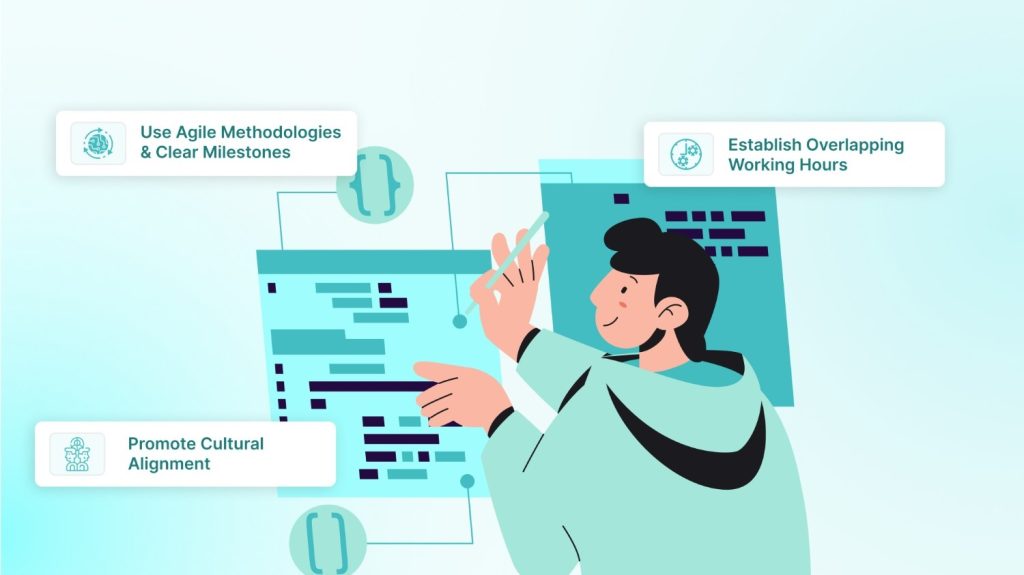
Managing an offshore software team successfully means more than handing off work; it means building a well‑coordinated, trusting, and adaptive partnership. Below are three foundational best practices that help onshore and offshore teams operate smoothly and deliver reliably.
Establish Overlapping Working Hours
Creating shared time daily fosters real collaboration and avoids delays. While offshore teams handle development during their day, overlapping hours allow onshore stakeholders to connect live when needed. Even a two or three-hour block can make a big difference.
Use that window for sprint planning, pairing sessions, and real-time feedback. Outside those hours, encourage detailed written handoffs in task tools like Jira or Slack. This handoff model keeps momentum without forcing the entire team into inconvenient schedules.
Use Agile Methodologies And Clear Milestones
Agile frameworks enable structured, repeatable, transparent builds across distributed teams. Shared sprint cycles, daily stand-ups, story-level task tracking, and sprint reviews knit teams together. Sprints align deliverables and surface blockers before they stall progress .
Request clarity on roles, who owns what, and how each handoff is managed. Use project tools like Jira or Trello to track progress. Pair that with video calls and shared dashboards to boost trust and situational awareness . Retrospectives at the end help the team reflect, improve, and adjust processes continuously.
Promote Cultural Alignment
Offshore teams bring diversity, which can be a tremendous asset, but only when cultural differences are acknowledged and set alongside shared norms. Spend time aligning norms around communication, decision style, feedback, and holidays.
Offer cultural guidelines and “team calibration” sessions to help each side understand how the other works . Encourage psychological safety so offshore voices can raise concerns. That intimacy builds trust and makes teams more resilient . Think twice before rotating staff aggressively; stable teams drive better cohesion.
By implementing these, you shape an offshore collaboration that feels less remote and more integrated. These practices reduce friction and accelerate value delivery.
Conclusion
Choosing the right offshore software development partner in 2025 means balancing opportunity with rigor. Offshore models offer clear advantages. But success depends on thoughtful oversight: clear requirements, structured communication, and legal protection.
Your offshore engagement can align with your business strategy. Practices like overlapping work hours, agile sprints, and cultural integration transform dispersed teams into cohesive units. When done right, offshore development accelerates innovation while preserving quality and control.
DEVtrust stands out in this landscape. With a U.S. hub, Indian delivery center, modern full-stack capabilities, strict security standards, and strong client communication, it encapsulates the strengths of next-gen offshore partnerships.
Explore DEVtrust’s software offerings today to elevate your development strategy with a partner built for scale and clarity.
Choosing The Best Offshore Software Development Company In 2025
Choosing the best offshore software development partner in 2025? Discover benefits, risks, top providers (DEVtrust, and more), and how to pick and manage them.
Contact Us